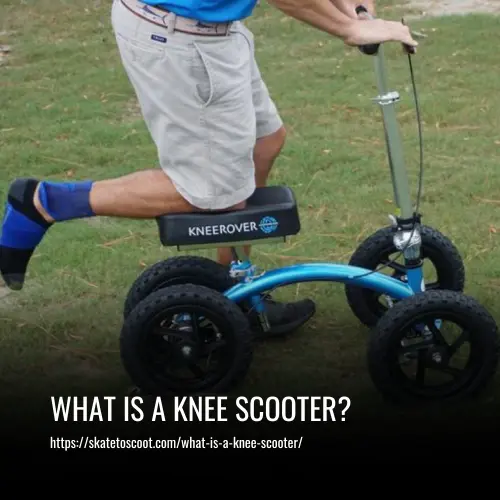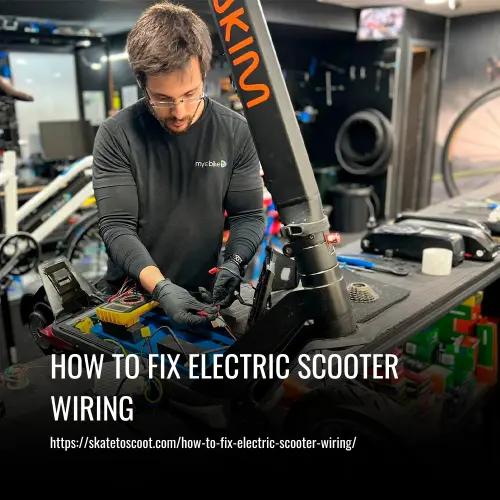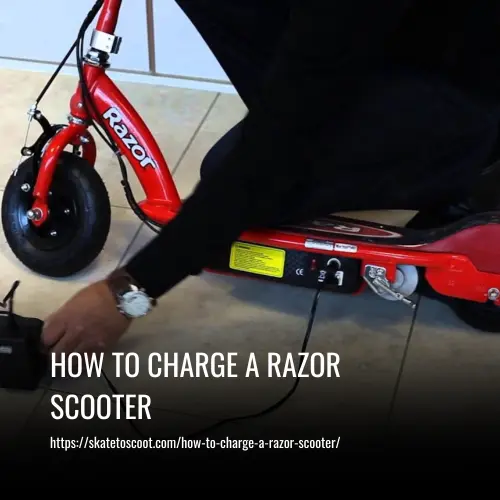As an Amazon Associate we earn from qualifying purchases.
A knee scooter, also known as a knee walker, is a mobility aid device that helps individuals with lower leg injuries move around more easily. It has three to five wheels, a knee rest support, and a steering handle. The injured leg is rested on the padded knee support, while the uninjured foot is used to propel the scooter forward.
Knee scooters are a popular alternative to crutches because they provide more comfort and freedom of movement. They allow individuals to continue their daily activities without the inconvenience of using crutches.

What Are Knee Scooters Used For
Knee scooters are mobility aids used by individuals who are unable to put weight on their injured foot or leg during rehabilitation. They provide a comfortable and efficient alternative to crutches, allowing the user to rest their leg on a padded knee platform while propelling themselves forward using their unaffected leg.
Knee scooters are recommended by doctors for conditions such as Achilles tendon rupture, ankle arthritis, ankle surgery recovery, and diabetic foot conditions, among others. They offer a convenient and practical solution for individuals facing a non-weight bearing period, enabling them to maintain their mobility and independence throughout the recovery process.
Types Of Knee Scooter
Knee scooters are healthcare devices designed to provide mobility and support for individuals with leg injuries or limited mobility. There are different types of knee scooters available, each catering to specific needs and situations.
There are several types of knee scooters available to suit different needs and preferences:
1. Indoor Knee Scooters
Specifically designed for indoor use, these knee scooters feature non-marking solid wheels and are suitable for flat and partially inclined smooth surfaces. They often have smaller wheels to allow for better maneuverability in tight spaces.
2. Outdoor Knee Scooters
These knee walkers, known as all-terrain knee scooters, are suitable for both indoor and outdoor use. They are equipped with larger air-filled rubber wheels that can handle bumpy roads and uneven surfaces, providing a smoother ride.
3. Seated Knee Scooters
Resembling a bicycle, seated knee scooters have four wheels and a footrest located at the front. Instead of using pedals for mobility, users can rest their injured or immobilized foot on the footrest and push forward with their strong leg. These scooters are recommended for individuals with weak balance or injured knees.
4. Pediatric Knee Scooters
To ensure both comfort and safety, walking aids like knee scooters need to be adjusted according to the user’s height. Pediatric knee scooters are specifically designed for children and users under 5’5″, providing a safe and suitable option for young individuals.
Features Of Knee Scooter
Knee scooters provide individuals with leg injuries or limited mobility the freedom to move around with ease. These devices come in various makes and models, each offering unique features to cater to different needs and situations.
1. Brakes
Many knee walkers are equipped with handlebar brakes, similar to those found on bicycles. This feature enables users to have better control over their movement and ensures a safe and smooth ride.
2. 3-wheeled vs. 4-wheeled models
Knee walkers come in both 3-wheeled and 4-wheeled options. While both versions are sturdy, 3-wheeled models are typically more compact and can easily maneuver through tighter spaces.
3. Baskets
Similar to bicycles, some knee walkers come with baskets attached. These baskets provide convenient storage for groceries, business items, or any other belongings that users may need to carry with them.
4. All-terrain wheels
Certain knee walkers are specifically designed with larger, wider wheels to navigate rougher terrains such as grass, dirt, or gravel-covered areas. These models are ideal for individuals who spend a significant amount of time outdoors.
5. Heavyweight capacity
Different individuals have different weights and knee walkers are available in models that can support heavier weight loads. It is important to choose a knee walker that matches your weight capacity for optimal safety and comfort.
When selecting a knee walker, it is essential to consider the features that suit your specific needs and circumstances.
How Do Knee Scooters Work
Knee scooters are mobility devices designed to provide individuals with leg injuries or limited mobility the ability to move around comfortably. These devices work by allowing the user to rest their injured leg on a padded platform, with the knee bent at a 90-degree angle.
The individual steers the scooter using handlebars and propels themselves forward by pushing off with their good leg. With four wheels for stability and maneuverability, knee scooters offer a safe and convenient alternative to traditional crutches.
Whether it’s for post-operative recovery, foot surgery, or any other non-weight bearing period, knee scooters provide a practical solution for individuals seeking mobility aids during their healing process.
How Much is a Knee Scooter
The cost of a knee scooter can vary depending on the specific model and features. Typically, the purchase price ranges from $125 to $400. Higher-priced models often come with more advanced capabilities and features. However, if purchasing is not the preferred option, renting a knee scooter is a great alternative.
Renting a knee scooter online can cost as little as $30 per week, with the convenience of having it shipped anywhere for free. This rental service is highly competitive in the market today.
Benefits of Using a Knee Scooter
Knee scooters offer numerous benefits for individuals with leg injuries or undergoing postoperative recovery. These innovative devices provide a convenient and comfortable alternative to traditional crutches. Here are some key benefits of using a knee scooter:
1. Comfort and Ease of Travel
Knee scooters are designed to provide maximum comfort and ease of travel. With features like padded knee rests and adjustable height settings, they ensure a comfortable and customized fit for each individual. Additionally, many models are lightweight and foldable, making them easy to transport and store.
2. Relief for Weight-Bearing Recovery Periods
One of the main advantages of using a knee scooter is that it helps relieve the pressure and strain on your injured leg during weight-bearing recovery periods. By allowing you to rest your injured leg on the padded knee platform, knee scooters provide a supportive and comfortable walking experience.
3. Stability and Safety
Knee scooters act as a safeguard for your injured leg, providing stability and preventing further strain or injury. However, it is important to follow basic safety tips, such as using the brakes correctly and avoiding slippery surfaces or steep inclines.
4. Improved Mobility
Using a knee scooter allows you to perform most of your daily activities with ease. Whether it’s moving around your house or workspace, knee scooters provide stability and allow you to use both your hands freely.
5. Convenience in Daily Tasks
Knee scooters are designed to make everyday tasks easier. They allow you to navigate through your home, including accessing the bathroom, with ease. Many models can be parked next to the toilet or sink, providing convenience for everyday activities.
6. Versatility and Specialized Options
Knee scooters come in a variety of models, including those specifically designed for outdoor use and those offering enhanced maneuverability for specialized tasks. These options ensure that you can find a knee scooter that suits your specific needs and environment.
Knee Scooter Safety Tips
When it comes to using a knee scooter, safety should always be the top priority. These mobility aids are designed to assist in your recovery, not cause further injuries or accidents. To ensure a safe and smooth experience, it’s crucial to follow these essential safety tips.
1. Lock in the brakes
Always engage the brakes when getting on and off the knee scooter. This provides extra stability and prevents it from rolling away.
2. Regulate your speed
Use the hand brakes to control your speed, especially if you feel you’re going too fast. Take extra caution when moving downhill to avoid unintentionally increasing your speed. Use your good foot as a brake as well when needed.
3. Pay attention to the surroundings
Be vigilant of inclines, rough sidewalks, or loose objects on the surface. Adjust your movement and speed accordingly.
4. Ensure Proper Adjustment
Make sure that the knee scooter is adequately adjusted to your size. The orientation of the knee rest, as well as the handlebar and knee rest height, should be appropriately set to provide maximum comfort and safety.
5. Transition Between Surfaces Carefully
When moving from one type of surface to another, be careful of transitions such as door thresholds. Rolling over these transitions can cause bumps or sudden changes in speed, so exercise caution and navigate them smoothly.
6. Avoid Sitting and Riding
To maintain balance and prevent accidents, it is important not to sit and ride the knee scooter. Always keep your body properly positioned while using the device.
7. No Speeding or Tricks
Resist the temptation to speed or perform tricks with the knee scooter. These actions increase the risk of accidents and injuries, so it’s best to prioritize safety over entertainment.
By following these knee scooter safety tips, you can ensure a safe and effective recovery experience.
What to Consider When Choosing a Knee Scooter
Choosing the right knee scooter is essential for a comfortable and safe recovery. Here are some important factors to consider when selecting a knee scooter:
1. Weight Capacity
Ensure that the knee scooter you choose can support your weight. Most models have a weight capacity of around 300 pounds, but it’s important to check the specifications to make sure it can safely accommodate your weight.
2. Adjustability
Look for a knee scooter that is adjustable to fit your height and weight properly. This will ensure a comfortable and stable ride. Some scooters also have adjustable handlebars and padded platforms for added customization.
3. Portability
If you plan on using your knee scooter outside of your home, consider its portability. Opt for a lightweight and easily foldable or disassemblable scooter for hassle-free transportation. Some scooters even come with carrying bags for added convenience.
4. Wheel Size
The size of the wheels can impact the scooter’s performance on different surfaces. Standard models typically have wheels of 7 to 8 inches, while all-terrain models come with larger 12-inch wheels that are similar to rubber pneumatic tires on a bicycle. Consider the terrain you’ll be using the knee scooter on to determine the most suitable wheel size.
By considering these factors, you can choose a knee scooter that is suitable for your needs and promotes a smooth and comfortable recovery.
FAQs
Knee scooters provide a more comfortable and stable alternative to crutches, allowing for increased mobility without putting weight on the injured foot or leg. They offer a smoother and more efficient way of getting around during the recovery period.
While knee scooters can work on carpets to some extent, they may not perform as smoothly as on hard surfaces. It is generally recommended to use them on flat and even surfaces for optimal stability.
The best knee scooter depends on individual needs and preferences. Factors such as weight capacity, adjustability, portability, and wheel size should be considered. Some popular options include the steerable knee scooter, all-terrain knee walker, and foldable knee scooter.
Yes, many knee scooters are designed to be portable and travel-friendly. Lightweight and foldable models are particularly convenient for transportation. Some even come with carrying bags for easy storage and mobility.
Insurance coverage for knee scooters varies depending on the insurance provider and specific policy. It is important to check with your insurance company to determine if knee scooters are covered and what requirements must be met for reimbursement.
A knee scooter is typically recommended for individuals who are non-weight bearing or have limited mobility due to a foot or ankle injury, foot surgery, or lower leg amputation. If you have difficulty using crutches or experience balance issues, a knee scooter may be a suitable alternative.
The duration of knee scooter use depends on the individual’s recovery and the severity of the injury. It is generally used during the non-weight bearing period, which can last from a few weeks to several months. Consult with your healthcare professional for guidance specific to your condition.
Some potential disadvantages of knee scooters include limited maneuverability in tight spaces, difficulty navigating stairs, and the need for upper body strength. Additionally, using a knee scooter for an extended period can lead to discomfort or pressure sores.
Knee scooters offer advantages over wheelchairs in terms of mobility and maintaining some level of activity during recovery. They allow users to elevate the injured leg and navigate more easily in various environments. However, the choice between a knee scooter and a wheelchair depends on the specific needs and mobility limitations of the individual.
Using a knee scooter requires a short learning curve for most people. While it may take some adjustments and practice to achieve stability and control, the intuitive steering and maneuverability make it relatively easy to use.
The terms “knee scooter” and “knee walker” are often used interchangeably to refer to the same type of mobility device. Both terms describe a wheeled device with a padded knee rest or platform used to support the injured leg or foot.
To make a knee scooter more comfortable, you can add cushioning or padding to the knee rest or platform. Additionally, adjusting the height and handlebars to suit your posture and using suitable footwear can contribute to a more comfortable riding experience.
Navigating stairs with a knee scooter can be challenging and is generally not recommended. It is advised to find alternative means of mobility, such as using a stairlift or relying on assistance when encountering stairs.
Knee scooters are commonly used with casts, as they provide a convenient and efficient way to get around while keeping weight off the injured foot or leg. The padded knee platform provides support and stability, making it suitable for individuals with casts.
Knee scooters are designed to provide relief and support for individuals with lower leg injuries or surgeries. They allow the injured knee or foot to rest comfortably without bearing weight, which can alleviate knee pain caused by mobility and weight-bearing activities.
Elderly individuals can use knee scooters if they have the necessary upper body strength and balance required. However, it is crucial to assess individual capabilities and consult with a healthcare professional to determine if a knee scooter is suitable.
Most knee scooters have weight capacities ranging from 250 to 350 pounds. It is essential to check the specifications of the specific model to ensure it can safely accommodate your weight.
A knee walker, or scooter, is suitable for individuals who have lower leg injuries, foot or ankle surgeries or are in a non-weight bearing period. They provide a convenient and efficient mobility solution for those who cannot bear weight on their injured leg or foot.
Individuals with severe balance issues or those who do not have sufficient upper body strength to maneuver a knee walker safely may not be suitable candidates. It is important to consult with a healthcare professional to determine if a knee walker is appropriate.
Yes, many knee scooters have adjustable features to accommodate different heights and body types. These adjustments include handlebar height, knee rest height, and sometimes even the angle of the knee platform, allowing for a customized fit.
Conclusion
In conclusion, a knee scooter is a practical and effective alternative to traditional crutches for individuals with leg injuries or undergoing foot or ankle surgery. With its padded knee rest and contoured knee platform, it provides comfort and support during the non-weight bearing period.
The steerable design and bicycle brake system allow for easy maneuverability and control, eliminating the need for upper body strength. Whether it’s a short recovery period or an extended period of time, a knee scooter offers enhanced mobility and independence.
Moreover, all-terrain knee scooters are available for individuals who need to navigate various surfaces. With a foldable design, it can be easily transported and stored.
Amazon and the Amazon logo are trademarks of Amazon.com, Inc, or its affiliates.


